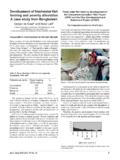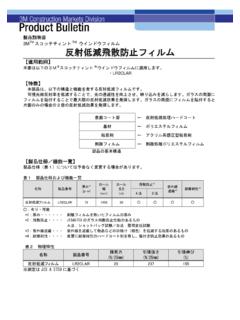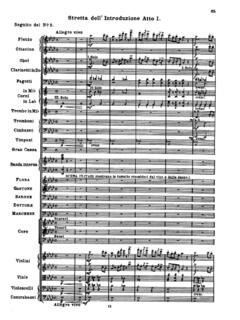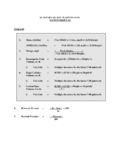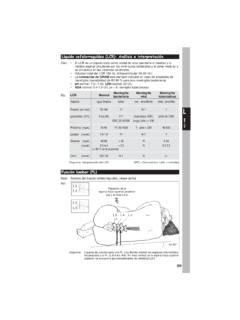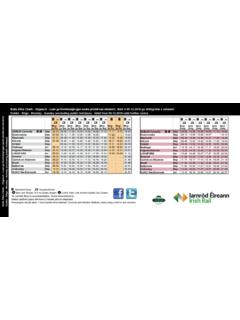Transcription of HANDBOOK ON THE ARTIFICIAL REPRODUCTION AND POND …
1 HANDBOOK ON THE ARTIFICIAL REPRODUCTION AND POND rearing OF THE AFRICAN CATFISH CLARIAS GARIEPINUS IN SUB-SAHARAN AFRICA A HANDBOOK FAO FISHERIES TECHNICAL PAPER 362 i HANDBOOK ON THE ARTIFICIAL REPRODUCTION AND POND rearing OF THE AFRICAN CATFISH CLARIAS GARIEPINUS IN SUB-SAHARAN AFRICA A HANDBOOK By Gertjan DE GRAAF and Johannes JANSSEN NEFISCO FOUNDATION AMSTERDAM, THE NETHERLANDS FAO, FISHERIES TECHNICAL PAPER 362 ROME, 1996 ii M-44 ISBN 92-5-103916 The designation employed and the presentation of material in this document do not imply the expression of any opinion whatsoever on the part of the United Nations or the Food and Agriculture Organization of the United Nations concerning the legal or constitutional status concerning the legal or constitutional status of any country, territory or sea, city or area, or of its authorities, or concerning the delimitation of its frontiers or boundaries.
2 Iii PREPARATION OF THIS DOCUMENT The African catfish, Clarias gariepinus has been reared for almost 20 years in Africa with mixed success; the total farm production of this species being only 3,978 metric tonnes or of the total farmed fish production of 69,434 mt in Africa in 1994. To a large extent the poor performance of this freshwater fish species in Africa has been due to the absence of reliable production techniques for the REPRODUCTION and rearing of the species under practical farming conditions The document is based on the practical field experience of Gertjan de Graaf and Johannes Janssen on the ARTIFICIAL REPRODUCTION and rearing of the African catfish within FAO field projects in the Central African Republic, The Republic of Congo, Kenya and Nigeria.
3 The manual has been written by the authors as a practical guide for the REPRODUCTION and pond rearing of the African catfish, based on methods which have proven to be successful and reliable in the field The manual was edited by Dr. Tacon and Ms. M. Page of the FAO Inland Water Resources and Aquaculture Service and produced as part of the ongoing activities of the service to help to meet the needs of aquaculture workers of Member Countries for the development of suitable farming techniques for the sustainable expansion of aquaculture production Distribution; FAO Fisheries Department; FAO Regional Fisheries Officers; FAO Aquaculture Projects; FAO Representatives; FAO Regional Fishery Commissions.
4 Directors of Fisheries and Aquaculture iv de Graaf, ; Janssen, ARTIFICIAL REPRODUCTION and pond rearing of the African catfish, Clarias gariepinus in sub-Saharan Africa A HANDBOOK FAO Fisheries Technical Paper. No 362. Rome, FAO. 1996. 73 p ABSTRACT The manual is based on the practical field experience of Gertjan de Graaf and Johannes Janssen on the ARTIFICIAL REPRODUCTION and rearing of the African catfish within FAO field projects in the Central African Republic, The Republic of Congo, Kenya and Nigeria.
5 The manual is divided into five major sections dealing with : 1) general biology, including feeding habits and REPRODUCTION ; 2) ARTIFICIAL REPRODUCTION , including induced propagation without and through hormone injection; 3) fry nursing in earthen ponds , including pond preparation, fertilization, feeding and management; 4) monoculture, including feeding methods; and 5) poly culture with Tilapia. In addition, information is provided concerning the economics of different fingerling and grow-out farming practices in Africa, and concerning diseases and hybridisation.
6 V TABLE OF CONTENTS 1. 2. THE AFRICAN CATFISH (CLARIAS GARIEPINUS AND CLARIAS ANGUILLARIS)..5 NATURAL GEOGRAPHICAL 3. DESCRIPTION OF THE GENUS AND HABITAT 11 NATURAL FOOD AND NATURAL OOCYTE 4. ARTIFICIAL GONADAL DEVELOPMENT IN INDUCED PROPAGATION WITHOUT HORMONE SEMI- ARTIFICIAL REPRODUCTION THROUGH HORMONE 25 Hormone induced REPRODUCTION in Hormone induced REPRODUCTION in happa placed in a Hormone induced REPRODUCTION in concrete tanks with a gravel ARTIFICIAL broodstock care and selection of ripe breeders 31 Hormone Maturation processes and stripping of the eggs 34 Incubation of fertilized 5.
7 FRY NURSING IN EARTHEN POND PREPARATION, FERTILIZATION AND FEEDING Daily supplementary IMPACT OF NURSING OF CATFISH LARVAE IN PROTECTED Stocking density of the catfish Size and form of the nursing Duration of the rearing period and cannibalism among the catfish Pond monitoring and predator 6 MONOCULTURE OF AFRICAN STOCKING FEEDING 62 7. POLY CULTURE OF AFRICAN CATFISH WITH NILE TILAPIA 73 8. Economics of fingerling Economics of polyculture and DISEASES 88 9 ANNEX I: ANOU IS RAISING CATFISH, A TRAINING FILM.
8 100 1. INTRODUCTION Pond culture is not a traditional farming practice in most parts of Africa. Introduced after the Second World War there was an initial spectacular development with about 300,000 ponds being operational, mainly rearing Tilapia spp, in about 20 African countries by the end of the fifties (Meschkat, 1967). Since then fish culture has not made much further progress and has in many cases even declined resulting in the abandonment of fish ponds by discouraged farmers.
9 According to the authors this failure has been attributed to: * The harvesting of too many small stunted tilapia from over populated ponds because of the use of poor husbandry techniques * The dependency on subsidized extension services and fingerling distribution centres. * Misjudgement of the motivation of the rural fish farmers by policy makers, and the creation of the myth that the rural farmer will willingly take up fish farming for food security or as a source of protein for their family.
10 This is most likely not the case, the primary motivation of rural fish farmer generally being income generation. * Failure to apply adequate resources (which may be naturally limiting) such as water and feed. By the end of the sixties, a reorientation to increase aquaculture production was proposed that included; * A modification of the farming technique for Tilapia in which seed production and on-growing to marketable sized fish are separated and the introduction of monosex tilapia culture (Pruginin, 1967 and Shell, 1968).
